“Harika içerikler yayınlıyorum ama kimse bulamıyor. Bu hayal kırıklığını WordPress kullanıcılarından her zaman duyuyoruz. İlk blogumuzu açtığımızda biz de aynı şekilde hissettik, SEO’yu anlamadığımız için yazılarımızın internet içeriğinin engin okyanusunda kaybolmasını izledik.
Bugüne geldiğimizde, Google’da üst sıralarda yer alan çok sayıda başarılı WordPress web sitesi oluşturduk. Bu süreçte, iyi SEO’nun karmaşık teknik numaralarla ilgili olmadığını, işe yarayan kanıtlanmış bir sistemi takip etmekle ilgili olduğunu keşfettik.
Bu eksiksiz kılavuzda, WordPress sitelerini arama motorları için optimize etmeye yönelik adım adım sürecimizi paylaşacağız. İster yeni başlıyor olun ister mevcut sitenizin sıralamasını iyileştirmek isteyin, WordPress SEO hakkında bilmeniz gereken her şeyi basitçe açıklanmış olarak bulacaksınız.
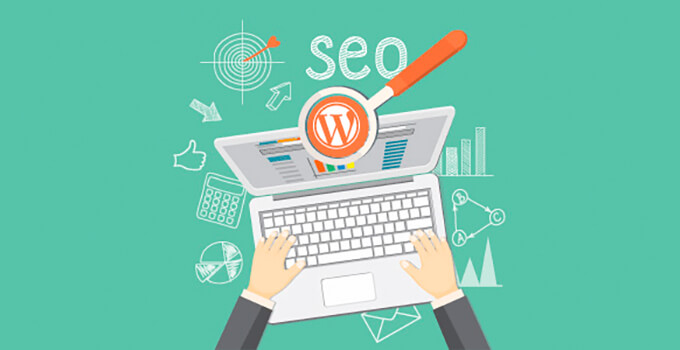
Muhtemelen WordPress’in SEO dostu olduğunu duymuşsunuzdur ve bu doğrudur. Bu yüzden birçok insan blog veya web sitesi açmak için WordPress’i tercih ediyor.
WordPress, SEO en iyi uygulamalarını takip eden temiz kodlarla oluşturulmuştur ve arama motorlarının içeriğinizi anlamasını ve dizine eklemesini kolaylaştırır.
Ancak, WordPress sağlam bir temel oluştursa da, web sitenizin görünürlüğünü en üst düzeye çıkarmak ve organik trafik çekmek için hala yapılması gereken işler var.
Bu kılavuz, hemen uygulamaya koyabileceğiniz eyleme geçirilebilir stratejilerle WordPress SEO’nuzu artırmak için kapsamlı bir yol haritası sunar.
Bu derinlemesine kılavuzda gezinmenize yardımcı olmak için aşağıda kullanışlı bir içindekiler tablosu oluşturduk:
İçindekiler
Giriş
WordPress SEO’nun Temelleri
- Sitenizin görünürlük ayarlarını kontrol edin
- WordPress’te SEO dostu URL yapısı kullanma
- URL’lerde WWW ve WWW olmayan
En İyi WordPress SEO Eklentisi
- En İyi WordPress SEO Eklentisini Seçme
- WordPress’te XML site haritaları ekleme
- Sitenizi Google Search Console’a ekleyin
- Blog yazılarınızı SEO için optimize etme
- Web siteniz için anahtar kelime araştırması yapmak
- Web sitenizi yerel SEO için optimize etme
WordPress SEO En İyi Uygulamaları
- WordPress’te kategorileri ve etiketleri doğru şekilde kullanma
- İç bağlantı kurmayı alışkanlık haline getirin
- Şema işaretlemesi ve zengin snippet’ler ekleyin
- WordPress yorumlarını optimize edin
- WordPress’te NoFollow harici bağlantılar
- Tam gönderiler vs özetler (alıntılar)
WordPress SEO için Hız ve Güvenlik
- Sitenizin hızını ve performansını optimize edin
- WordPress’teki görselleri SEO için optimize etme
- WordPress sitenizin güvenliği ve emniyeti
- SSL/HTTPS kullanmaya başlayın
Son olarak, WordPress SEO’nuzu daha da ileriye taşımak için daha fazla SEO aracı ve kaynağı görün.
Giriş
WordPress SEO için optimizasyon fikrinin yeni başlayanlar için korkutucu olabileceğini biliyoruz, özellikle de teknoloji meraklısı değilseniz.
Ama endişelenmeyin, karmaşık olmak zorunda değil. Temel bilgileri öğrenmek için buradan başlayın ve ardından bunları kendi web sitenize uygulamaya başlayabilirsiniz:
SEO Nedir?
SEO, Arama Motoru Optimizasyonu anlamına gelen bir kısaltmadır. Web sitesi sahipleri tarafından çevrimiçi görünürlüklerini artırmak ve arama motoru sonuçlarında, özellikle de Google’da daha üst sıralarda yer alarak daha fazla ziyaretçi çekmek için kullanılan bir stratejidir.

SEO’yu bir kütüphaneyi düzenlemek gibi düşünün. Kitapların okuyucuların onları bulmasına yardımcı olmak için net bir sisteme ihtiyaç duyması gibi, web sitenizin de arama motorlarının insanlar ilgili konuları aradıklarında içeriğinizi bulabilmesi ve önerebilmesi için organize edilmesi gerekir.
Arama motoru optimizasyonu Google’ı kandırmak veya sistemle oynamak değildir. Aslında optimize edilmiş kod, net biçimlendirme ve değerli içeriğe sahip iyi yapılandırılmış bir web sitesi oluşturmakla ilgilidir.
İnsanlar internette yazdığınız konularla ilgili arama yaptığında, bu optimizasyon çalışmaları içeriğinizin arama sonuçlarında daha üst sıralarda görünmesine yardımcı olarak daha fazla ziyaretçinin web sitenizi doğal yollarla bulmasını sağlar.
SEO Neden Önemli?
Arama motorları çoğu web sitesi için en büyük trafik kaynağıdır.
Google ve diğer arama motorları, sayfaları anlamak ve arama sonuçlarında uygun şekilde sıralamak için gelişmiş algoritmalar kullanır. Ancak bu algoritmalar mükemmel değildir, içeriğinizin ne hakkında olduğunu anlamak için hala sizin yardımınıza ihtiyaçları vardır.
Optimize edilmemiş içeriğin, değerli ve iyi yazılmış olsa bile sıralamada zorlandığı sayısız örnek gördük. İçeriğiniz uygun şekilde optimize edilmemişse arama motorları onu nasıl sıralayacağını bilemez.
Bu, insanlar yazdığınız konuları aradıklarında web sitenizin arama sonuçlarında görünmeyebileceği ve değerli trafiği kaçırmanıza neden olabileceği anlamına gelir.
Deneyimlerimize dayanarak, tüm işletme sahiplerinin web sitelerini arama motoru dostu hale getirmelerinin çok önemli olduğuna inanıyoruz. SEO’ya yapılan bu basit yatırım, çevrimiçi görünürlüğünüzü önemli ölçüde artırabilir ve daha fazla potansiyel müşteriye ulaşmanıza yardımcı olabilir.
WordPress SEO’nun Temelleri
SEO teknik olabilir, ancak öyle olmak zorunda değildir. Sitenizi optimize etmek için birkaç temel WordPress SEO ipucunu öğrenmek, web sitenizin trafiğinde gözle görülür bir artış sağlayabilir.
Aşağıdaki teknikleri kullanmak için bir teknoloji dehası olmanıza gerek yok. Zaten WordPress kullanıyorsanız, gerekenlere sahipsiniz demektir!
Web sitenizi optimize etmeye başlayalım.
Not: Web sitenizi SEO için optimize etmenin çok zor olduğunu düşünüyorsanız veya yeterli zamanınız yoksa, bunu sizin için yapması için WPBeginner Pro Services ‘teki uzmanları kiralayabilirsiniz.
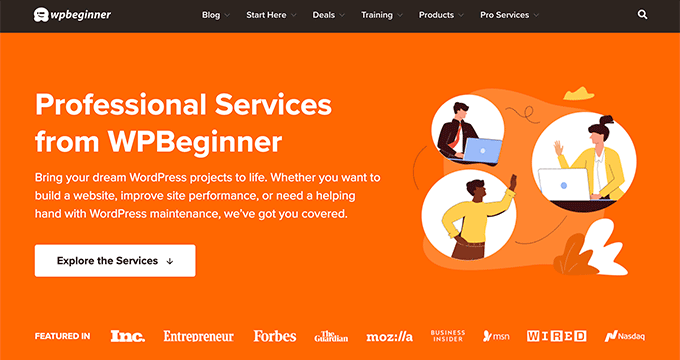
Web sitenizin trafiğini uygun fiyatlarla büyütmenize yardımcı olmak için WordPress SEO hizmetleri sunuyoruz. Hizmet, AIOSEO eklentisi kurulumu, sayfa içi optimizasyon, MonsterInsights kurulumu ile Google Analytics, anahtar kelime araştırması ve daha fazlasını içerir.
Sitenizin Görünürlük Ayarlarını Kontrol Edin
WordPress, web sitenizi arama motorlarından gizlemek için yerleşik bir seçenekle birlikte gelir. Bu seçenek, halka açılmaya hazır olmadan önce web siteniz üzerinde çalışmanız için size zaman tanır.
Ancak, bazen bu seçenek yanlışlıkla işaretlenebilir ve web sitenizi arama motorları için kullanılamaz hale getirir.
Web siteniz arama sonuçlarında görünmüyorsa, yapmanız gereken ilk şey bu seçeneğin işaretli olmadığından emin olmaktır.
WordPress sitenizin yönetici alanında oturum açın ve Ayarlar ” Okuma sayfasını ziyaret edin.

‘Arama Motoru Görünürlüğü’ bölümüne ilerlemeniz ve ‘Arama motorlarının bu siteyi indekslemesini engelle’ seçeneğinin yanındaki kutunun işaretli olmadığından emin olmanız gerekir.
Değişikliklerinizi kaydetmek için ‘Değişiklikleri Kaydet’ düğmesine tıklamayı unutmayın.
WordPress’te SEO Dostu URL Yapılarını Kullanma
SEO dostu URL’ler sayfanın içeriğini net bir şekilde açıklayan kelimeler içerir ve hem insanlar hem de arama motorları tarafından okunmaları kolaydır.
SEO dostu URL’lere bazı örnekler şunlardır:
https://www.wpbeginner.com/tr/how-to-install-wordpress/https://www.wpbeginner.com/tr/common-wordpress-errors-and-how-to-fix-them/
Bu URL’lerin okunabilir olduğuna ve bir kullanıcının sadece URL metnine bakarak sayfada ne göreceğini tahmin edebileceğine dikkat edin.
Peki, SEO dostu olmayan bir URL neye benzer?
https://www.wpbeginner.com/tr/?p=10467
http://example.com/archives/123
Bu URL’lerin içerikle ilgisi olmayan numaralar kullandığına ve kullanıcının URL’ye bakarak sayfada ne bulacağını tahmin edemeyeceğine dikkat edin.
SEO dostu bir kalıcı bağlantı yapısı kullanmak, arama sonuçlarında daha iyi konumlar elde etme şansınızı artırır.
WordPress sitenizin kalıcı bağlantı yapısını nasıl kontrol edebileceğiniz ve güncelleyebileceğiniz aşağıda açıklanmıştır.
Ayarlar ” Kalıcı Bağlantılar sayfasını ziyaret etmeniz gerekir. Gönderi adı seçeneğini seçin ve ardından ayarlarınızı saklamak için ‘Değişiklikleri Kaydet’ düğmesine tıklayın.
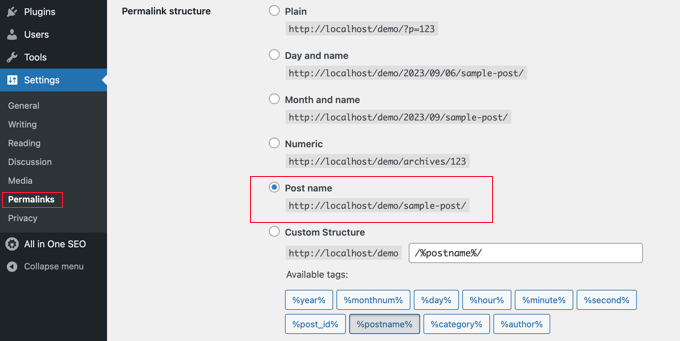
Daha ayrıntılı talimatlar için WordPress’te SEO dostu URL yapısının ne olduğuna ilişkin kılavuzumuza göz atın.
Not: Web siteniz 6 aydan uzun süredir çalışıyorsa, sayılar seçeneğini kullanmadığınız sürece lütfen kalıcı bağlantı yapınızı değiştirmeyin. Gün ve Ad veya Ay ve Ad kullanıyorsanız, bunu kullanmaya devam edin.
Yerleşik bir sitede kalıcı bağlantı yapınızı değiştirdiğinizde, tüm sosyal medya paylaşım sayılarınızı kaybedecek ve mevcut SEO sıralamanızı kaybetme riskiyle karşı karşıya kalacaksınız.
Kalıcı bağlantı yapınızı değiştirmeniz gerekiyorsa, uygun yönlendirmeleri ayarlayabilmesi için bir profesyonel ile çalışın. Yine de sayfalardaki sosyal paylaşım sayılarınızı kaybedeceksiniz.
WWW’ye karşı WWW olmayan
Web sitenizle yeni başlıyorsanız, sitenizin URL’sinde www (http://www.example.com) veya www olmayan (http://example.com) kullanmak isteyip istemediğinizi seçmeniz gerekir.
Arama motorları bunları iki farklı web sitesi olarak değerlendirir, bu nedenle birini seçmeniz ve ona bağlı kalmanız gerektiği anlamına gelir.
Tercihinizi Ayarlar ” Genel sayfasını ziyaret ederek ayarlayabilirsiniz. Tercih ettiğiniz URL’yi hem ‘WordPress Adresi’ hem de ‘Site Adresi’ alanlarına ekleyin.
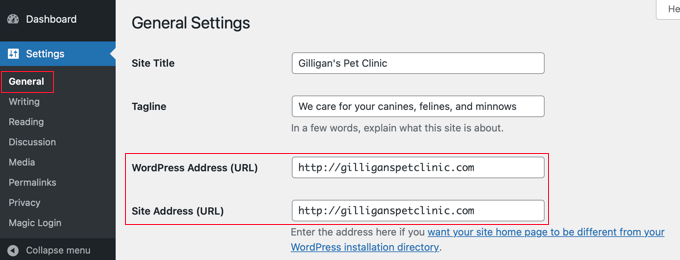
Bir başkası ne derse desin, SEO açısından birini veya diğerini kullanmanın hiçbir avantajı yoktur.
Bu konu hakkında daha ayrıntılı bilgi için www vs non-www – WordPress SEO için hangisi daha iyi rehberimize göz atın.
En İyi WordPress SEO Eklentisi
WordPress ile ilgili en iyi şeylerden biri, her şey için bir eklenti olmasıdır ve SEO da bir istisna değildir. Binlerce seçenek var, bu da yeni başlayanların en iyi WordPress SEO eklentisini seçmesini zorlaştırıyor.
Tek tek SEO görevleri için ayrı eklentiler kurmak yerine, hepsini yapan ve %100 ücretsiz olan en iyi WordPress SEO eklentisini seçmenize yardımcı olacağız.
En İyi WordPress SEO Eklentisini Seçme
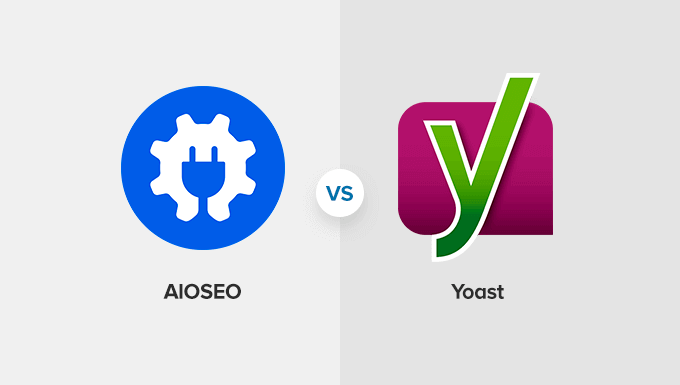
En iyi WordPress SEO eklentisini seçmek söz konusu olduğunda, büyük olasılıkla seçeneklerinizi en popüler iki çözümle daraltacaksınız: All in One SEO (AIOSEO) veya Yoast SEO.
Deneyimlerimize göre, bu gibi premium SEO eklentileri çoğu web sitesi için buna değer, ancak bütçeniz kısıtlıysa, her iki çözüm de başlamanıza izin veren ücretsiz sürümler sunar.
AIOSEO, 3 milyondan fazla web sitesinde kullanılan orijinal WordPress SEO eklentisidir.
Bu, WPBeginner web sitesinde kullandığımız eklentidir.
TruSEO sayfa içi analizi, zengin snippet şema işaretlemesi, sosyal medya entegrasyonları, breadcrumb navigasyonu, WooCommerce için gelişmiş e-Ticaret SEO desteği, yerel SEO, dahili bağlantı asistanı ve çok daha fazlası dahil olmak üzere WordPress SEO’yu otomatikleştirmek için güçlü özelliklerle birlikte gelir.
Basitçe söylemek gerekirse, AIOSEO WordPress siteniz için tüm teknik SEO optimizasyonunu gerçekleştirir.
Bu eğitimde, ekran görüntüleri ve örnekler için AIOSEO kullanacağız.
Daha fazla ayrıntı için WordPress için All In One SEO’nun nasıl kurulacağına ilişkin eksiksiz kılavuzumuza bakabilirsiniz.
Yoast SEO kullanıyorduk, ancak daha hızlı yenilik yaptığı ve daha güçlü özelliklere sahip olduğu için All in One SEO’ya geçtik. Daha fazla ayrıntı için Yoast’tan AIOSEO‘ya geçiş nedenlerimiz hakkındaki kılavuzumuza bakın.
WordPress’te XML Site Haritaları Ekleme
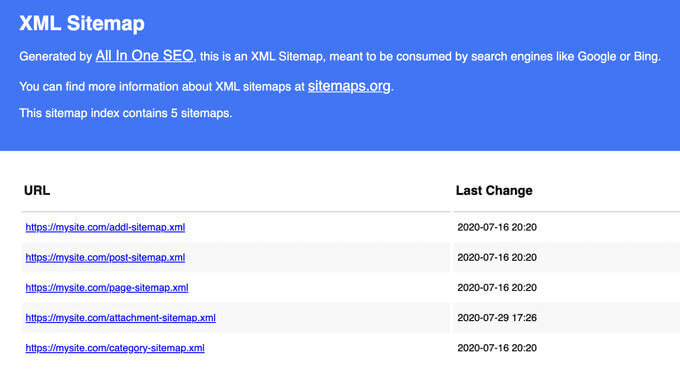
XML site haritası, web sitenizdeki her bir sayfayı listeleyen özel olarak biçimlendirilmiş bir dosyadır. Bu, arama motorlarının tüm içeriğinizi bulmasını kolaylaştırır.
XML site haritası eklemek sitenizin arama sıralamasını yükseltmese de arama motorlarının sayfaları hızlı bir şekilde bulmasına ve sıralamaya başlamasına yardımcı olur.
AIOSEO eklentisini kullanıyorsanız, sizin için otomatik olarak bir XML site haritası oluşturacaktır. Site haritanızı bulmak için bu URL’ye gidin ( example.com yerine kendi alan adınızı yazmayı unutmayın):
http://example.com/sitemap.xml
XML site haritanızı Google’a nasıl göndereceğinizi bir sonraki adımda göstereceğiz.
Sitenizi Google Search Console’a Ekleyin
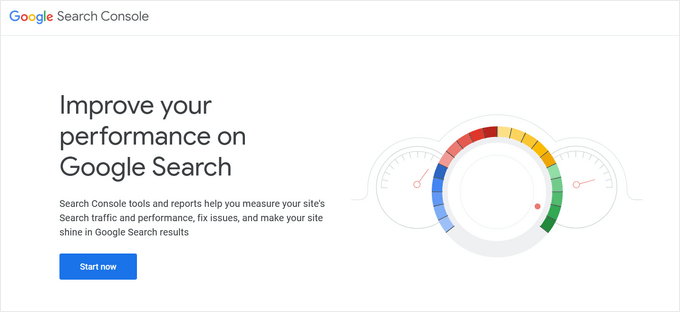
Web Yöneticisi Araçları olarak da bilinenGoogle Search Console, Google tarafından sunulan ve web sitesi sahiplerinin içeriklerinin arama motoru tarafından nasıl görüldüğünü görmelerini sağlayan bir dizi araçtır.
Sayfalarınızın arama sonuçlarında nasıl göründüğünü anlamanıza yardımcı olacak raporlar ve veriler sağlar. Ayrıca, insanların web sitenizi bulmak için kullandıkları gerçek arama terimlerini, her sayfanın arama sonuçlarında nasıl göründüğünü ve sayfalarınızın ne sıklıkla tıklandığını da görebilirsiniz.
Tüm bu bilgiler, sitenizde neyin işe yarayıp neyin yaramadığını anlamanıza yardımcı olur. Daha sonra içerik stratejinizi buna göre planlayabilirsiniz.
Google Search Console ayrıca web sitenizde bir sorun olduğunda, örneğin arama tarayıcıları web sitenize erişemediğinde, yinelenen içerik veya kısıtlanmış kaynaklar bulduğunda sizi uyarır.
AIOSEO kullanıyorsanız, Google Search Console’u nasıl ekleyeceğinize dair bu kılavuzu takip edebilirsiniz.
AIOSEO kullanmıyorsanız, alternatif bir yol gösteren videomuzu izleyebilirsiniz:
WordPress sitenizi Google Search Console‘a nasıl ekleyeceğinize ilişkin bu adım adım kılavuzu da okuyabilirsiniz.
Web sitenizi Google Search Console’a ekledikten sonra, sol menüden ‘Site Haritası’na tıklayın ve ardından site haritası URL’sinin son kısmını yapıştırın.
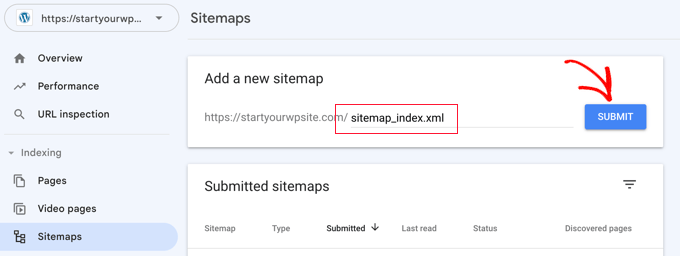
Değişikliklerinizi kaydetmek için ‘Gönder’ düğmesine tıklamayı unutmayın.
Google Search Console artık site haritanızı kontrol edecek ve web sitenizin taranmasını iyileştirmek için kullanacaktır.
Site haritanızı başarıyla ekledikten sonra, beklemede olarak görünecektir. Google’ın web sitenizi taraması biraz zaman alır.
Birkaç saat sonra, site haritanızla ilgili bazı istatistikleri görebileceksiniz. Site haritanızda bulduğu bağlantıların sayısını, kaç tanesinin dizine eklendiğini, resimlerin ve web sayfalarının oranını ve daha fazlasını gösterecektir.
İçgörü toplamak ve web sitenizin SEO ilerlemesini görmek için Search Console’unuzu en az ayda bir kontrol etmenizi öneririz.
Güncelleme: AIOSEO ekibi, WordPress sitenizin içinde tam bir arama istatistikleri panosuna sahip olmanızı sağlayan Google Search Console entegrasyonuna sahiptir.
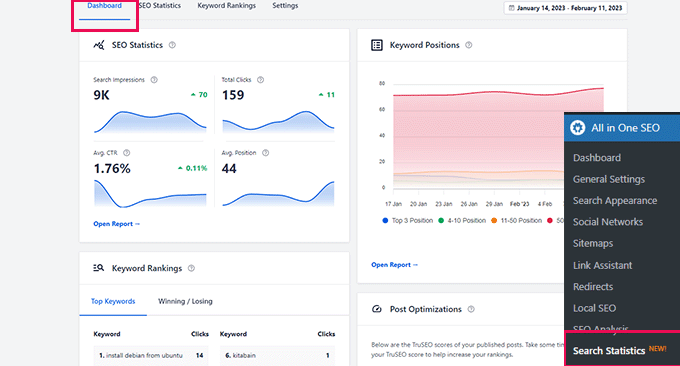
Google Search Console’un yanı sıra, web sitenizi Bing, Yahoo, DuckDuckGo ve diğerleri gibi diğer popüler arama motorlarına da göndermenizi öneririz.
Çeşitli arama konsollarının yanı sıra, organik trafiğinizi analiz etmek için MonsterInsights ‘ı da kullanmalısınız. MonsterInsights, Google Analytics’ten gelen bilgileri doğrudan WordPress kontrol panelinizden görmenizi kolaylaştırır.
MonsterInsights ile WordPress’te Google Analytics’i nasıl yükleyeceğinizi öğrenmek için bu eğitimi izleyin.
Blog Yazılarınızı SEO için Optimize Etme
Yeni başlayanlar genellikle bir WordPress SEO eklentisi kurup etkinleştirmenin tek gereken şey olduğunu düşünme hatasına düşerler. SEO, maksimum sonuçları görmek istiyorsanız ayak uydurmanız gereken devam eden bir süreçtir.
En iyi SEO eklentilerinin tümü, her blog gönderisine ve sayfasına bir SEO başlığı, meta açıklama ve odak anahtar kelime eklemenize olanak tanır. Ayrıca, kullanıcıların web sitenizi Google’da arattıklarında ne göreceklerinin bir önizlemesini de gösterir.
Arama motoru sonuçlarında maksimum tıklama almak için başlığınızı ve açıklamanızı optimize etmenizi öneririz.
Blog yazınızı yazarken, SEO bölümüne kaydırın ve bundan tam olarak yararlanın.
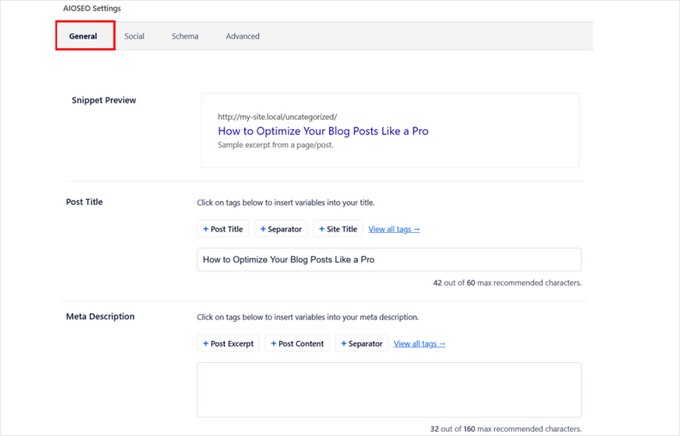
Odak anahtar kelimeyi veya odak anahtar cümleyi nasıl seçeceğinizi ya da iyi bir başlık veya meta açıklamayı nasıl yazacağınızı merak ediyorsanız, blog yazılarınızı SEO için optimize etmeye yönelik yeni başlayanlar kılavuzumuzda bu konuyu ayrıntılı olarak ele aldık.
Ayrıca, yazarken içeriğinizin güçlü ve zayıf yönlerini ve performansını analiz etmek için SEO kontrol araçlarını kullanmanızı öneririz. Bu, yazarken blog yazılarınızın netliğini, alaka düzeyini ve kullanıcı etkileşimini nasıl geliştirebileceğinizi vurgulayacaktır.
Sayfa içi SEO, SEO stratejinizin başarısı için çok önemli olduğundan okumanızı şiddetle tavsiye ederiz.
Web Siteniz İçin Anahtar Kelime Araştırması Yapma
Yeni başlayanların çoğu, insanların hangi konuları aradıklarını ve bloglarına ve web sitelerine ne eklemeleri gerektiğini anlamak için en iyi tahminlerini kullanır.
Karanlıkta ok atmak gibi bir şey. İnsanların ne aradığını bulmak için gerçek verileri kullanabildiğinizde bunu yapmanıza gerek kalmaz.
Anahtar kelime araştırması, içerik oluşturucular ve SEO uzmanları tarafından kullanılan bir araştırma tekniğidir. Kullanıcıların sektörünüzdeki içerik, ürün ve hizmetleri bulmak için arama motorlarına girdikleri kelimeleri keşfetmenize yardımcı olur.
Daha sonra daha fazla arama trafiği elde etmek için bu kelimeleri ve ifadeleri web sitenizde kullanabilirsiniz.
Kullanabileceğiniz çok sayıda anahtar kelime araştırma aracı (hem ücretsiz hem de ücretli) vardır. Rekabetin düşük olduğu anahtar kelimeleri keşfetmenize ve hatta rakiplerinizin sıralandığı anahtar kelimeleri bulmanıza yardımcı olduğu için LowFruits ‘i kullanmanızı öneririz.
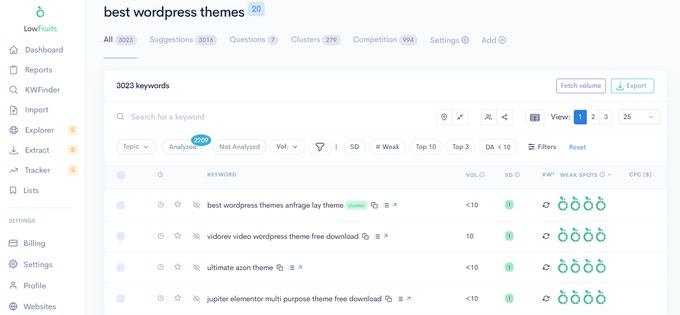
Ayrıca SEO konu kümeleri oluşturmanıza yardımcı olabilecek bir Anahtar Kelime Kümeleme özelliği ile birlikte gelir. Bu, otoritenizi oluşturmanıza ve daha ilgili anahtar kelimeler için sıralama yapmanıza yardımcı olabilir.
Ücretsiz bir alternatif arıyorsanız, WPBeginner Anahtar Kelime Oluşturucuyu kullanabilirsiniz. Ücretsiz olarak indirilebilir bir raporda anında 300’den fazla anahtar kelime fikri oluşturmanıza olanak tanır.
WPBeginner ayrıca, hangi anahtar kelimeler için optimizasyon yaptıklarını ortaya çıkarmak için rakibinizin URL’sini girmenize olanak tanıyan ücretsiz bir Anahtar Kelime Yoğunluğu Denetleyicisine sahiptir.
Daha fazla ayrıntı için WordPress web siteniz için anahtar kelime araştırmasının nasıl yapılacağına ilişkin başlangıç kılavuzumuza bakın.
Web Sitenizi Yerel SEO için Optimize Etme
Çevrimiçi mağazanızın veya işletmenizin restoran, perakende satış mağazası veya bölge ofisi gibi fiziksel bir konumu varsa, yerel SEO için de optimize etmeniz gerekir. Bu, kullanıcılar kendi bölgelerindeki sizinki gibi işletmeleri aradıklarında web sitenizin yerel arama sonuçlarında listelenmesini sağlayacaktır.
Örneğin, bir kişi ‘yakınımdaki İtalyan restoranları’ aramasını yaptığında, arama sonuçlarında bir liste ve harita üzerinde yakınındaki ilgili işletmeleri görecektir.
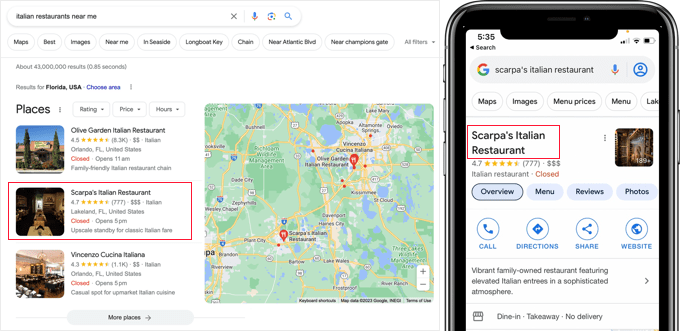
Bu gibi “yakınımda alışveriş var” aramaları küresel olarak yıldan yıla %100 artıyor.(kaynak) Bu, işletmenizin yerel arama sonuçlarında yer almaması durumunda değerli trafiği kaybedeceğiniz anlamına gelir.
Yerel arama sıralamalarını etkileyen temel faktörler şunlardır:
- Bir Google İşletme kaydına sahip olmak
- Gerçek müşterilerden gelen olumlu yorumları görüntüleme
- İşletme bilgilerinizin ve içeriğinizin doğru anahtar kelimelerle eşleştiğinden emin olmak
- Adınızın, iş adresinizin ve telefon numaranızın tüm çevrimiçi platformlarda tutarlı olmasını sağlamak
- İşletmeniz arama yapan kişiye yakın
Web sitenizde yerel işletme şema işaretlemesini kullanmak, arama motorlarının işletme bilgilerinizi doğru bir şekilde anlamasına yardımcı olacaktır.
Bu yapılandırılmış verileri sitenize eklemenin en kolay yolu All in One SEO (AIOSEO) kullanmaktır. Premium Yerel SEO modülü, konum verileri, iletişim bilgileri, çalışma saatleri, adım adım yol tarifi içeren haritalar ve çok daha fazlasını eklemenizi sağlar.
İşletmenizin birden fazla konumu varsa endişelenmeyin. Tüm mağazalarınız veya ofisleriniz için yerel bilgiler eklemek için AIOSEO’daki ‘Çoklu Konumlar’ ayarını değiştirmeniz yeterlidir.
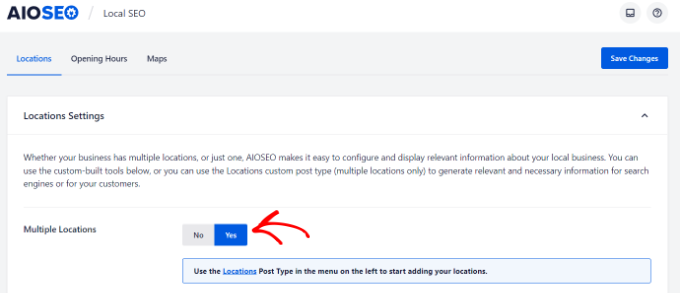
WordPress SEO En İyi Uygulamaları
WordPress SEO’nun temellerini takip ederseniz ve en iyi WordPress SEO eklentisini kullanırsanız, zaten çoğu web sitesinin önünde olacaksınız.
Ancak, daha da iyi sonuçlar almak istiyorsanız, aşağıdaki WordPress SEO en iyi uygulamalarını takip etmeniz gerekir.
Bunlar çok teknik değildir ve çoğu herhangi bir koda dokunmanızı bile gerektirmez. Ancak bunları uygularsanız büyük bir fark yaratacaklardır.
WordPress’te Kategorileri ve Etiketleri Doğru Kullanma

WordPress, blog yazılarınızı kategoriler ve etiketler halinde sıralamanıza olanak tanır. Bu, içeriğinizi konulara göre yönetmenizi ve kullanıcılarınızın aradıkları içeriği bulmalarını kolaylaştırır.
Kategoriler ve etiketler, arama motorlarının web sitenizin yapısını ve içeriğini anlamasına da yardımcı olur.
Yeni başlayanlar genellikle kategorileri ve etiketleri en iyi şekilde nasıl kullanacakları konusunda kafa karışıklığı yaşarlar. Bunu binlerce okuyucuya açıkladıktan sonra, işte kategorilere ve etiketlere nasıl yaklaştığımız.
Kategoriler, yazılarınızın geniş bir şekilde gruplandırılması içindir. Blogunuz bir kitap olsaydı, kategoriler içindekiler tablosu olurdu.
Örneğin, kişisel bir blogda müzik, yemek ve seyahat gibi kategorileriniz olabilir. Kategoriler hiyerarşiktir, bu nedenle bunlara alt kategoriler ekleyebilirsiniz.
Öte yandan etiketler, tek bir gönderinin içeriğini tanımlayan daha spesifik anahtar kelimelerdir. Örneğin, yemek kategorisi altında dosyalanmış bir blog yazısı salata, kahvaltı ve krep gibi etiketlere sahip olabilir. Bunları bir ders kitabındaki dizin bölümleri gibi düşünün.
Bu konuda daha fazla bilgi için kategorilere karşı etiketler ve içeriğinizi sıralamaya yönelik en iyi SEO uygulamaları hakkındaki kılavuzumuza bakın.
Kategorileri ve etiketleri doğru kullanarak, kullanıcılarınızın web sitenize göz atmasını kolaylaştırırsınız. Kullanıcılar için kolay olduğu için, arama motorlarının web sitenize göz atmasını da kolaylaştırır.
Kategorilerinizi ve etiketlerinizi arama için optimize etme hakkında daha fazla bilgiyi taksonomi SEO kılavuzumuzda bulabilirsiniz.
Dahili Bağlantıyı Alışkanlık Haline Getirin
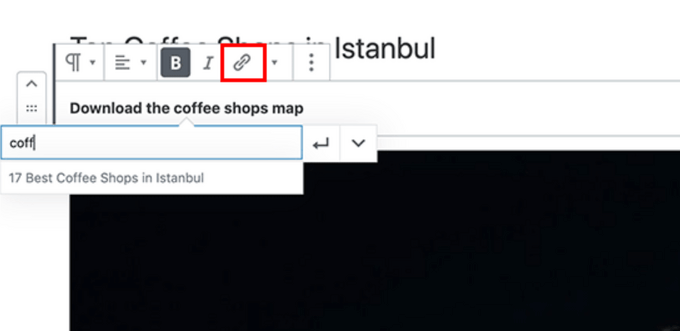
Arama motorları web sitenizdeki her sayfaya ‘sayfa otoritesi’ adı verilen bir puan verir. Bu puanın tarifi gizli tutulur, böylece insanlar sonuçlarla oynayamaz. Ancak, otoritenin en yaygın sinyalleri bağlantılardır.
Bu nedenle, diğer blog yazılarınızdan ve sayfalarınızdan kendi içeriğinize bağlantı vermeniz önemlidir.
Mümkün olduğunca kendi yazılarınız arasında bağlantı kurmayı alışkanlık haline getirmelisiniz. Birden fazla yazarınız varsa, yayın öncesi bir blog yazısı kontrol listesi oluşturarak en az 3 başka blog yazısı arasında bağlantı kurmalarını isteyebilirsiniz.
Bu, sayfa görüntülemelerinizi artırmanıza, kullanıcıların sitenizde geçirdiği süreyi artırmanıza ve nihayetinde bireysel blog yazılarınızın ve sayfalarınızın SEO puanını iyileştirmenize yardımcı olacaktır.
Web sitenize bağlantı eklemek çok zaman alabilir ve önemli bir şeye bağlantı vermeyi unutmak kolaydır. WordPress için bir SEO bağlantıları eklentisi kullanarak dahili bağlantıları daha kolay hale getirebilirsiniz.
Örneğin, All in One SEO ekibi WordPress Link Assistant adlı bir özellik oluşturdu.
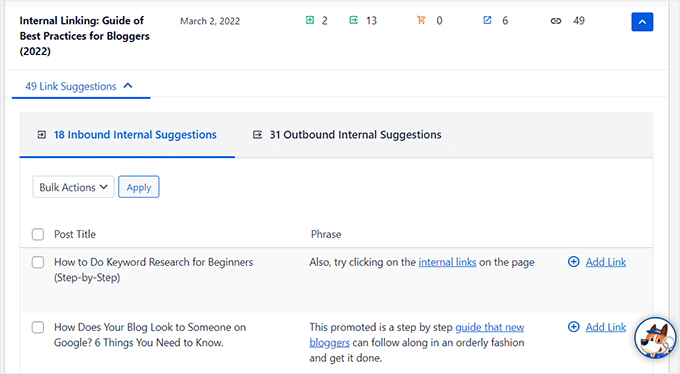
Link Assistant, WordPress sitenizdeki bağlantıları otomatik olarak tarar ve içeriğinize tek tıklamayla ekleyebileceğiniz alakalı iç bağlantı önerileri sunar.
Basitçe söylemek gerekirse, büyük bir zaman tasarrufu sağlayan iç bağlantıları toplu olarak ekleme işlemini otomatikleştirir.
WordPress için en iyi dahili bağlantı eklentileri listemizde bu konuda daha fazla bilgi edinebilirsiniz. Ayrıca SEO için en iyi uygulamaları içeren dahili bağlantı kılavuzumuzu da okumak isteyebilirsiniz.
İlgili: All in One SEO ayrıca ücretsiz Broken Link Checker eklentisini de yayınladı. Doğru çalıştıklarından emin olmak için tüm dahili bağlantılarınızı otomatik olarak tarar. Bozuk bağlantılar bulunursa, URL’leri doğrudan eklentinin içinden hızlı bir şekilde düzeltebilirsiniz.
Şema İşaretleme ve Zengin Snippet’ler (SSS Şeması, İncelemeler ve Daha Fazlası)
Google arama sonuçlarında bazı web sitesi listelerinin neden daha fazla öne çıktığını hiç merak ettiniz mi? Belki de yanlarında yıldız derecelendirmeleri vardır veya altlarında SSS soruları ile çok daha büyüktürler.
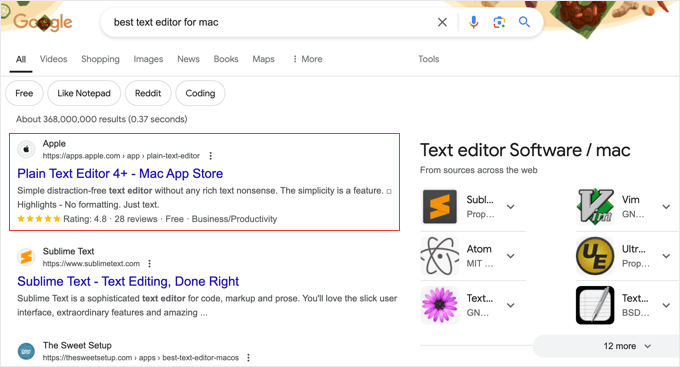
Google’ın en alakalı sonuçları arama listelerinin en üstünde göstermesinin farklı yolları vardır. Bunlar arasında Google yanıt kutuları, zengin snippet‘ler ve AI genel bakışları yer alır.
Google ve diğer arama motorlarında zengin snippet’ler elde etmenin en iyi yolu şema işaretlemesi kullanmaktır. Özel şema, web sitenizin öne çıkmasına yardımcı olur, böylece daha iyi bir tıklama oranı (TO) elde edebilirsiniz. Bu da WordPress sitenizin SEO’da daha üst sıralarda yer almasına yardımcı olur.
Şimdi, şema işaretlemenin gerçekten nasıl çalıştığını merak ediyor olabilirsiniz.
Düz İngilizce’de şema işaretlemesi, arama motorlarına içeriğiniz hakkında daha fazla bilgi vermek için WordPress web sitenize ekleyebileceğiniz özel bir HTML kodu türüdür.
Örneğin, arama motorlarına belirli bir sayfanın bir blog yazısı, yemek tarifi, SSS, haber makalesi veya çevrimiçi mağazanızdaki bir ürün sayfası olduğunu söyleyebilirsiniz. Arama motorları daha sonra bu verileri zengin sonuçlar görüntülemek için kullanabilir.
Şimdi, iyi haber şu ki, çoğu web sitesi sahibi aslında şema işaretlemesi eklemek için kod eklemiyor.
AIOSEO gibi güçlü WordPress SEO eklentileri, bu ayarları yazı ve sayfa düzenleyicinize ekleyerek bunu sizin için zaten yapıyor. Her yazı için şema işaretlemesini daha da özelleştirebilirsiniz. Bunun nasıl yapılacağına ilişkin daha fazla ayrıntıyı zengin snippet’lerin nasıl kullanılacağına ilişkin başlangıç kılavuzumuzda ele aldık.

Örneğin, WordPress’e SSS şeması eklemek istiyorsanız, tek yapmanız gereken SSS şema şablonunu seçmek ve soruları buraya eklemektir. AIOSEO perde arkasında JSON+LD şema işaretleme kodunu web sitenize ekleyecektir (siz herhangi bir teknik çalışma yapmadan).
Bu eklendiğinde, web sitenizin listesi Google’da bu şekilde daha fazla öne çıkacaktır.
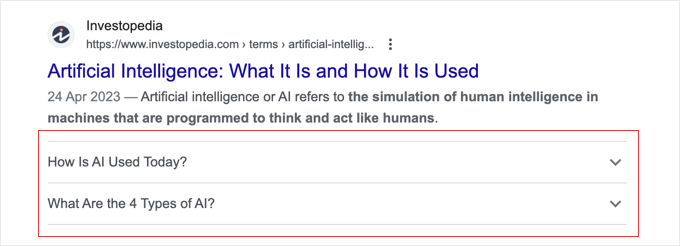
Benzer bir tekniği yemek tarifi şeması, ürün şeması, etkinlik şeması ve diğer şema işaretleme türlerini eklemek için de kullanabilirsiniz.
Kullanıcılarımıza her zaman AIOSEO’daki özel şema işaretleme aracından yararlanarak web sitenizi öne çıkarmalarını ve böylece SEO sıralamalarınızı iyileştirmelerini öneriyoruz.
WordPress Yorumlarını Optimize Edin

Yorumlar, web sitenizdeki kullanıcı etkileşiminin güçlü bir göstergesi olabilir. Etkileşimli kullanıcılar sitenize daha fazla bağlantı, daha fazla trafik ve gelişmiş SEO anlamına gelir.
Ancak, yorumlarınızın gerçek olduğundan ve spam olmadığından emin olmanız gerekir. Spam gönderenler kötü bağlantılar içeren yorumlar gönderir ve bu da arama sıralamanızı etkileyebilir ve hatta mahvedebilir.
Bu yüzden herkese Akismet‘i kullanmaya başlamalarını öneriyoruz. Her WordPress sitesine önceden yüklenmiş olarak gelen iki eklentiden biridir ve yorum spam’iyle mücadele etmenize yardımcı olur.
Akismet tek başına yorum spam’iyle başa çıkamıyorsa, WordPress’te yorum spam’iyle mücadele etmek için bu ipuçlarına ve araçlara bakın.
Blog yazılarınız çok sayıda gerçek ve spam içermeyen yorum alıyorsa, bu kadar ilgi çekici bir web sitesi oluşturduğunuz için kendinizi tebrik etmelisiniz!
Ancak bir gönderiye çok fazla yorum yapılması gönderinin daha yavaş yüklenmesine neden olabilir ve bu da arama motoru sıralamalarınızı etkiler. (Hızın SEO’yu nasıl etkilediği hakkında daha fazla bilgi edinmek için aşağıda okumaya devam edin).
Web sitenizi, yorumların sunucunuza ve hızınıza getirdiği yükü kaldırabilecek şekilde hazırlamak için yorumları birden fazla sayfaya bölebilirsiniz. WordPress‘te yorumların nasıl sayfalandırılacağına ilişkin eğitimimize göz atın.
Sitenizde daha fazla yorum almak istiyorsanız, WordPress blog yazılarınıza daha fazla yorum almanın bu yollarına göz atın.
WordPress’te NoFollow Harici Bağlantılar
Yukarıda da belirtildiği gibi, bağlantılar arama motorlarının hangi sayfaların önemli olduğuna karar vermesine yardımcı olur. Bir web sitesine bağlantı verdiğinizde, sitenizin SEO puanının bir kısmını bu bağlantıya aktarmış olursunuz. Bu SEO puanına ‘bağlantı suyu’ denir.
İyi bir arama sıralaması için, diğer web sitelerinden verdiğinizden daha fazla bağlantı suyu aldığınızdan emin olmanız gerekir.
Harici bağlantılara (size ait olmayan web sitelerine verilen bağlantılar) ‘nofollow’ özelliğini eklemek, arama motorlarına bu bağlantıları takip etmemeleri talimatını verir. Bu, bağlantı gücünden tasarruf etmenize yardımcı olur.
Normal bir harici bağlantı HTML’de şu şekilde görünür:
<a href="http://example.com">Example Website</a>
Nofollow özelliğine sahip bir harici bağlantı şu şekilde görünür:
<a href="http://example.com" rel="nofollow">Example Website</a>
WordPress varsayılan olarak bağlantıları nofollow yapmak için bir seçenek sunmaz. Ancak, AIOSEO eklentisini kullanıyorsanız, bunu sizin için kolaylaştırır.
Bir bağlantı eklediğinizde, Bağlantıya “nofollow” ekle seçeneğine tıklamanız yeterlidir.
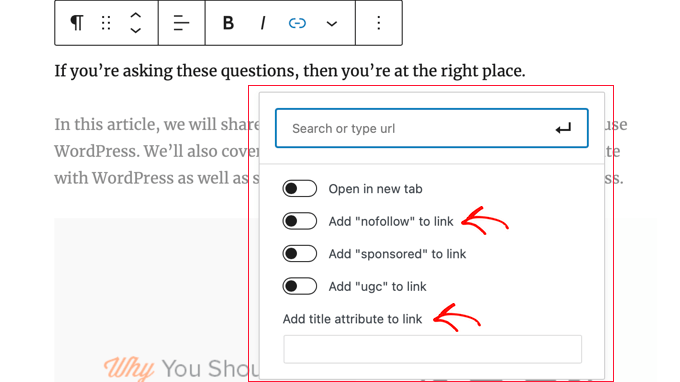
Daha fazla ayrıntı ve alternatif yöntemler için WordPress’te nofollow bağlantıların nasıl ekleneceğine ilişkin kılavuzumuza bakın.
Tam Yazılar vs. Özetler veya Alıntılar
WordPress, ana sayfa, kategori arşivi, etiket arşivi, tarih arşivi, yazar sayfaları ve daha fazlası gibi bir dizi sayfadan yazılarınızı görüntüler ve bunlara bağlantı verir.
Varsayılan olarak, tüm bu sayfalarda makale içeriğinin tamamını gösterir. Arama motorları bunu yinelenen içerik olarak algılayabileceğinden, bu durum sitenizin SEO’sunu etkiler. Tam makaleler ayrıca arşiv sayfalarınızın daha yavaş yüklenmesine neden olur.
Makalelerin tamamını her yerde göstermek sayfa görüntülemelerinizi de etkiler. Örneğin, RSS beslemenize abone olan kullanıcılar, web sitenizi hiç ziyaret etmeden makalenin tamamını besleme okuyucularından okuyabileceklerdir.
Bunu çözmenin en kolay yolu, makalelerin tamamı yerine özetlerini veya alıntılarını göstermektir.
Bunu Ayarlar ” Okuma bölümüne gidip alıntı seçeneğini belirleyerek yapabilirsiniz.
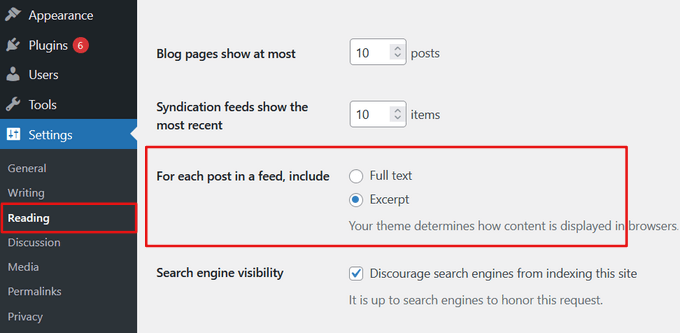
Ayrıntılı talimatlar için kodlama yapmadan WordPress alıntılarını özelleştirme kılavuzumuza bakın.
WordPress SEO için Hız ve Güvenlik
Yukarıdaki tüm WordPress SEO ipuçlarını ve en iyi uygulamaları takip etseniz bile, siteniz yavaşsa veya bir hacker tarafından çökertilirse, arama motoru sıralamalarınız büyük bir darbe alacaktır. Bu,‘teknik SEO‘ olarak bilinir.
Sitenizin yavaş performans veya gevşek güvenlik nedeniyle arama motoru trafiğini kaybetmesini nasıl önleyeceğiniz aşağıda açıklanmıştır.
Sitenizin Hızını ve Performansını Optimize Edin
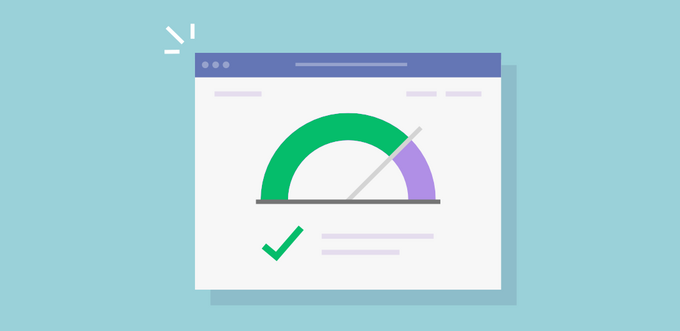
Araştırmalar, internet çağında ortalama bir insanın dikkat süresinin bir Japon balığınınkinden daha kısa olduğunu gösteriyor.
Web kullanılabilirlik uzmanları, kullanıcıların bir web sitesini ziyaret ettikten sonra birkaç saniye içinde kalmak ya da ayrılmak istediklerine karar verdiklerine inanmaktadır.
Bu, bir web sitesi sahibi olarak içeriğinizi sunmak ve kullanıcıların ilgisini çekmek için yalnızca birkaç saniyeniz olduğu anlamına gelir. Bu değerli zamanı, ziyaretçinizi web sitenizin yüklenmesini bekleterek boşa harcamak istemezsiniz.
Kullanıcı deneyimi çok önemli olduğu için, Google gibi arama motorları sonuçlarında daha hızlı web sitelerine öncelik verir. Başka bir deyişle, daha hızlı web siteleri Google’da daha üst sıralarda yer alır.
Web sitenizin hızını artırmak için SiteGround veya Hostinger gibi hızlı bir WordPress barındırma sağlayıcısına sahip olmalısınız(Bonus: Hostinger kupon kodumuzla%79 indirim kazanın!)
Bundan sonra, bir önbellek eklentisi yüklemeniz ve WordPress’i hızlandırmak için nihai kılavuzumuzu takip etmeniz gerekir.
WordPress’te Görselleri SEO için Optimize Etme
Görseller metinden daha ilgi çekicidir, ancak yüklenmesi de daha fazla zaman alır. Görüntü boyutlarına ve kalitesine dikkat etmezseniz, web sitenizi yavaşlatabilirler.
Daha hızlı yüklenmesi için optimize edilmiş görseller kullandığınızdan emin olmanız gerekir. Web için görselleri optimize ederek WordPress’i nasıl hızlandıracağınıza ilişkin kılavuzumuza göz atın.
Görsellerinizi arama motorları için optimize etmek için kullanabileceğiniz bir diğer numara da açıklayıcı bir başlık ve alt etiketler kullanmaktır. Bu etiketler arama motorlarının görselinizin ne hakkında olduğunu anlamasına yardımcı olur. Ayrıca, ekran okuyucuları alt metni okuyabildiği için görme bozukluğu olan kullanıcılara da yardımcı olurlar.
WordPress, bir resim yüklediğinizde kolayca başlık ve alt etiket eklemenize olanak tanır.
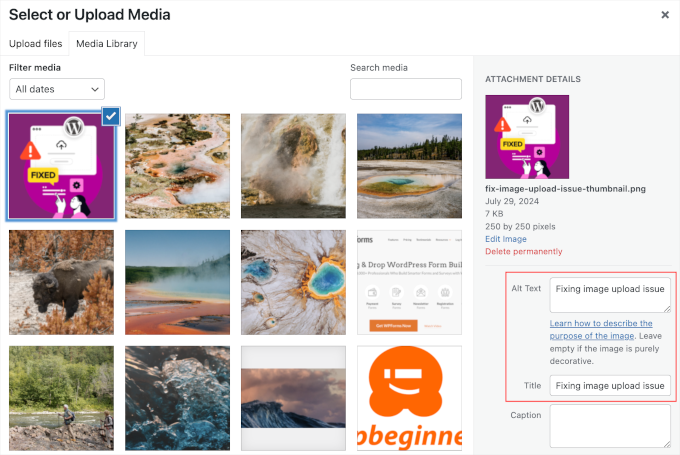
Bir fotoğrafçıysanız veya WordPress sitenize çok sayıda resim ekliyorsanız, bir galeri eklentisi kullanmanız gerekir.
AIOSEO ile birlikte Envira Gallery eklentisini kullanmanızı öneririz. Hız testlerimizde, en hızlı WordPress galeri eklentisi olduğunu gördük. Ayrıca tamamen duyarlı ve kutudan çıktığı haliyle SEO dostu.
Daha fazla ipucu için yeni başlayanlar için görsel SEO kılavuzumuza bakın.
Ve eğer video içeriğiniz varsa, bu da optimize edilmelidir. Ayrıntılar için WordPress’te video SEO’sunun nasıl düzgün bir şekilde ayarlanacağına ilişkin adım adım kılavuzumuza bakabilirsiniz.
WordPress Sitenizin Güvenliği ve Emniyeti
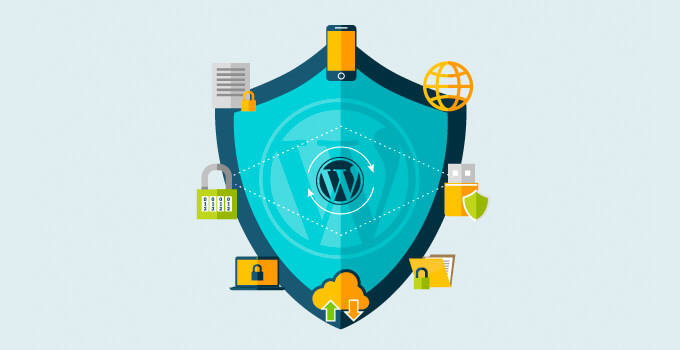
Google her hafta yaklaşık 20.000 web sitesini kötü amaçlı yazılım ve yaklaşık 50.000 web sitesini de kimlik avı nedeniyle kara list eye almaktadır. Bir site kara listeye alındığında, hiçbir arama sonucunda görünmez.
Bu, WordPress sitenizin güvenliğinin iyi sıralamalar için çok önemli olduğu anlamına gelir. Siteniz bir bilgisayar korsanı tarafından ele geçirilirse SEO için yaptığınız tüm sıkı çalışmaların boşa gitmesini istemezsiniz.
İyi haber şu ki WordPress sitenizi güvende tutmak o kadar da zor değil. Nihai WordPress güvenlik kılavuzumuzdaki adım adım talimatlara bakın.
WPBeginner’da, web sitemizi saldırılara karşı korumak için şu anda Cloudflare kullanıyoruz ve uzun yıllar Sucuri kullandık. Bu tür hizmetleri neden önerdiğimizi görmek için Sucuri’nin 3 ayda 450.000 WordPress saldırısını engellememize nasıl yardımcı olduğunu anlatan vaka çalışmamızı okuyun.
SSL/HTTPS Kullanmaya Başlayın
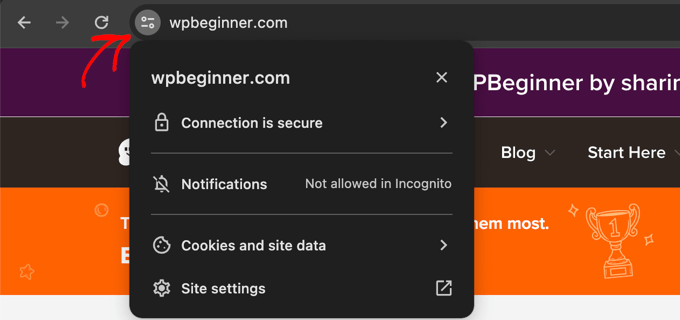
SSL (Secure Sockets Layer), kullanıcının tarayıcısı ile bağlandığı sunucu arasındaki bağlantıyı şifreleyen bir teknolojidir. Bu, WordPress sitenize ek bir güvenlik katmanı ekler.
SSL ile güvence altına alınan web siteleri, tarayıcının adres çubuğunda bir asma kilit veya ‘ayar’ simgesiyle gösterilir. Bu, web sitenizi daha güvenilir hale getirir ve WordPress ile çevrimiçi bir mağaza işletiyorsanız ve hassas ödeme bilgilerini işliyorsanız gereklidir.
En iyi WordPress barındırma şirketlerinin tümü Let’s Encrypt ile ücretsiz SSL sertifikaları sunar. Daha fazla ayrıntı için web siteniz için nasıl ücretsiz SSL sertifikası alacağınıza ilişkin kılavuzumuza bakın.
Birinci sınıf bir joker SSL sertifikası veya sadece güvenlik garantili normal bir sertifika istiyorsanız, Domain.com‘u kullanmanızı öneririz.
SSL sertifikaları minimum 10.000 $ ve 1,75 milyon $’a kadar güvenlik garantisi ile birlikte gelir. Ayrıca daha fazla güvenilirlik için sitenizde görüntülemek üzere bir TrustLogo site mührü alırsınız.
Video Eğitimi
Eğer yazılı talimatları tercih ediyorsanız, o zaman okumaya devam edin.
Daha Fazla SEO Aracı ve Kaynağı
WordPress SEO’nun en iyi uygulamalarını öğrendikten sonra, rakiplerinizin önüne geçmek için becerilerinizi daha da ileriye taşımak isteyeceksiniz.
SEO’nuzu güçlendirmek için en iyi WordPress SEO eklentileri ve araçlarının bir listesini derledik.
En iyi WordPress SEO eklentileri ve araçları için ilk 5 önerimiz şunlardır:
- All in One SEO olarak da bilinenAIOSEO, 3 milyondan fazla web sitesi tarafından kullanılan en iyi WordPress SEO eklentisidir. AIOSEO’nun ücretsiz bir sürümü de mevcuttur.
- Semrush, en iyi anahtar kelime araştırma ve rakip analizi aracı için seçimimizdir. Pahalı olmasına rağmen, gerçekten çok güçlü ve Profesyoneller için 1 numaralı seçim. (Ücretsiz Alternatifler: WPBeginner Keyword Generator ve Keyword Density Checker).
- MonsterInsights, tüm önemli istatistikleri tek bir yerde görmenize yardımcı olan en iyi Google Analytics eklentisidir. Unutmayın, ölçemediğiniz şeyi geliştiremezsiniz. MonsterInsights’ı 3 milyondan fazla web sitesi kullanıyor. Ücretsiz MonsterInsights Lite sürümü de mevcuttur.
- Lowfruits, Google sıralamalarınızı izlemenize ve sıralaması daha kolay olan düşük rekabetli anahtar kelimeleri belirlemenize yardımcı olacak güçlü bir anahtar kelime araştırma aracıdır. Rakiplerinizi geride bırakmanıza ve sitenize organik trafik çekmenize yardımcı olabilir.
- SEOBoost, yüksek sıralamalı içerik yazmanıza yardımcı olan yapay zeka destekli bir yazma asistanıdır. Blog yazılarınızda kullanabileceğiniz en iyi anahtar kelimeleri belirler ve sayfa içi SEO’nuzu artırmak için içeriğinizi anahtar kelime yoğunluğu, okunabilirlik ve alaka düzeyi açısından analiz eder.
Daha gelişmiş teknikler denemeye hazırsanız WordPress SEO makaleleri arşivimize de göz atabilirsiniz. Aşağıda, yararlı bulabileceğiniz özenle seçilmiş bazı kılavuzlar yer almaktadır:
- Sıralamanızı yükseltmek için WordPress SEO denetimi kontrol listesi
- WordPress siteniz için SEO raporu nasıl oluşturulur?
- SEO sonuçlarını hızlandırmak içinWordPress’e IndexNow nasıl eklenir?
- WordPress SEO tarama bütçesi sorunu ve nasıl düzeltileceği
- WordPress siteniz için Google Sitelinkleri nasıl edinilir
- SEO sıralamalarını yükseltmek içinWordPress’te içindekiler tablosu nasıl oluşturulur?
- SEO sıralamalarını iyileştirmek içinWordPress’te RSS site haritası nasıl eklenir?
- WordPress sitenizi Google Haberler’e nasıl gönderirsiniz?
- WordPress’te bir sayfa veya URL nasıl yeniden yönlendirilir
- WordPress’te tam site yönlendirmesi nasıl yapılır?
- Sesli Arama SEO’su – WordPress blogunuzu sesli arama için nasıl optimize edersiniz?
Bu makalenin WordPress sitenizi SEO için nasıl düzgün bir şekilde optimize edeceğinizi öğrenmenize yardımcı olduğunu umuyoruz. Devam edin ve bu WordPress SEO ipuçlarından birkaçını uygulayın; arama motorları değişikliklerinizi işledikçe birkaç ay içinde trafiğinizde bir artış göreceksiniz.

Have a question or suggestion? Please leave a comment to start the discussion.